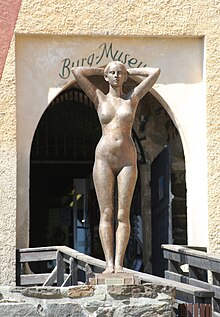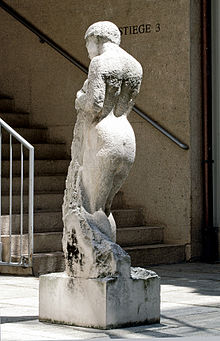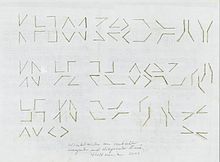Hortensia Fussy
Hortensia Fussy (born March 25, 1954 in Graz ; artist name: Hortensia ) is an Austrian sculptor .

Life
From 1970 to 1972 Hortensia studied sculpture at the Kunstgewerbeschule Graz under Josef Pillhofer and from 1972 to 1975 at the Academy of Fine Arts Vienna under Fritz Wotruba . She was his last student. She has been a freelance artist since 1975. During numerous trips to Europe and Africa, the artist creates cycles of drawings and watercolors as spatial images of landscapes, mountain ranges and architecture (including landscape cycle Spain (1983–1985), Tuscany and Umbria (1987–1990), Portugal (1997). , Dalmatia (1999–2002), Egypt (2000), Sicily (2002), Italian Dolomites (2003–2018)). From 2003 to 2012 she ran the drawing school Hortensia for figure and landscape, Bad Gams , West Styria .
On May 2nd, 2015 she opened the SCULPTURE HOUSE HORTENSIA in Bad Gams, West Styria. As a permanent exhibition space, it houses sculptures from various creative periods. The artist's workroom is located in the adjacent building.
In 2019 she was awarded the Golden Decoration of Honor for Services to the Republic of Austria by Federal President Alexander van der Bellen and presented it on November 26, 2019 by Governor Hermann Schützenhöfer.

Artistic activity
The focus of the work of the Austrian sculptor, draftsman and painter Hortensia is the human figure. “Your sculptural work is in the tradition of classical modernism. She creates modern classic-figurative works that are characterized by form reduction and rigor, occasionally archaic, absolute technical security and full mastery of artistic means. Her oeuvre is an important position in Austrian figurative sculpture. "
“Hortensia Fussy continues a line of development in the visual arts in Austria, at the beginning of which Gustav Klimt and Egon Schiele can be placed and which was continued by artists such as the painter Herbert Boeckl and the sculptor Josef Pillhofer . However, the greatest influence on Hortensia Fussy's artistic career came from her teacher, the important Austrian sculptor Fritz Wotruba . "
In an early phase of work, “Hortensia gives the departure into the third dimension a special place in her work, which transcends the usual connection between drawn preliminary studies and executed sculpture. With figures based on pictures by Piero della Francesca , Francisco de Goya , Albrecht Dürer or Jan Vermeer , she took this path of “spatialization” in the early 1980s ”and a. "Figure after Goya", 1980; "Figure after Dürer", 1981; "Hommage a Courbet", 1988-95.
The form is always the central theme of Hortensia and the starting point of her artistic work. "Under the heading" Form and Figure ", Hortensia deals with some principles according to which the perceptual material picked up by the eyes is arranged so that it can be grasped by the human mind." The interplay of both terms opens up access to Hortensia's aesthetic imperative: " My figures should be earthy, centered, sensual and measured! ”. "The point here is that the negative, the positive, that the curve, the horizontal, the horizontal, the diagonal, that is, essential spatial dimensions, which ultimately also determine our vision, can change the viewer's view of things." Hortensia's work is based on the consistent application of the "pictorial alphabet" she herself developed with this clarity. The pictorial alphabet of Hortensia is a summary of 24 angular connections, which are formed from a combination of a vertical, horizontal or inclined line. These symbols are a kind of font for the implementation of descriptive reality in the pictorial work. It was in the book "Hortensia - Form und Raum" (2014). documented.
From 2002 to 2010 the artist carried out a series of exhibitions entitled “Form und Figur”, among others in the Styrian Fire Brigade Museum, 2002; Bratislava, 2003; Washington, 2004; Moscow, 2008; Deutschlandsberg Castle, 2009–2010. From 2014 this concept was expanded and continued under the title "Form und Raum".
Awards
- 1987: Theodor Körner Prize
- 1999: Liesl Bareuther Award, Künstlerhaus Vienna
- 2014: Great Decoration of Honor of the State of Styria
- 2019: Decoration of Honor in Gold for Services to the Republic of Austria

Permanently exhibited works (selection)
- Monument to President Rudolf Sallinger , Rudolf Sallinger Platz, Vienna
- Caryatid , Deutschlandsberg Castle
- Figure after Goya , Collection Vienna Insurance Group, Ringturm Vienna
- Hommage a Courbet - Palais Harrach, Vienna (until 2014), since then Rathausplatz Deutschlandsberg
- Muse3 (after Correggio) - Langenzersdorf Museum (formerly Hanak Museum)
Solo exhibitions (selection)
- 1984: Galerie Würthle, Vienna, Austria
- 1990: Galerie Norbert Blaeser, Düsseldorf, Germany
- 1997: International Festival Sarajevo Winter, Bosnia & Hercegovina
- 1998: Forum Lagos 1998, Portugal
- 1998: Kulturhaus, Graz, Austria
- 2001: Cairo Opera Art Gallery, Egypt.
- 2002: Styrian Fire Brigade Museum Groß St. Florian, Austria
- 2004: Austrian Embassy, Washington , USA
- 2008: Central House of Artists, Moscow , Russia
- 2009–2010: Museum Archeo Norico, Deutschlandsberg Castle, Austria
- 2011: "Sculptures and their perspectives", University of Graz, UZT, Austria
- 2014: "Form and Space", Museum Archeo Norico, Deutschlandsberg Castle, Austria
- 2016: "Form und Raum", Langenzersdorf Museum (formerly Hanak Museum), Austria
- 2018: Grazer Landhaus , Steinerner Saal
literature
- Form and Figure , 2002.
- Form und Figur (sculptures) , 2008, ISBN 978-80-969998-0-4 .
- Double Games , 2009, ISBN 978-3-9502799-0-0 .
- Form and Space , 2014, ISBN 978-3-9502799-1-7 .
Web links
Individual evidence
- ↑ Mag. Gabriele Stöger-Spevak: On the work of HORTENSIA. Sculpture House HORTENSIA, October 1, 2016, accessed on January 7, 2020 .
- ↑ Mag. Gabriele Stöger-Spevak, from “Hortensia - Form and Space”, Langenzersdorf Museum, exhibition opening on October 1, 2016.
- ↑ Robert Gerschner, from "Form und Figur", 2008.
- ↑ Hans-Walter Ruckenbauer, from "Statik, Rhythmik und Proportion", 2011.
- ↑ Konstantin Denchev, art historian, from "Form und Figur", 2008.
- ↑ Hortensia: Quotation from "Form und Figur", 2008.
- ↑ Werner Fenz , Universalmuseum Joanneum, "The Topos Figure in Space", 2008.
- ↑ Hortensia - Form and Space, 2014.
- ↑ Hortensia Fussy: Form and Figure from October 3, 2008 Moscow, Central House of Artists.
- ^ Hortensia Fussy: Form and Figure: Pictures from the Exhibition Opening in Moscow .
| personal data | |
|---|---|
| SURNAME | Fussy, Hortensia |
| ALTERNATIVE NAMES | Hortensia |
| BRIEF DESCRIPTION | Austrian sculptor |
| DATE OF BIRTH | March 25, 1954 |
| PLACE OF BIRTH | Graz |

